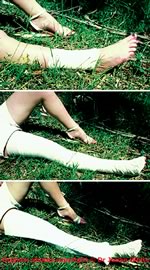|
|
|
First Aid
|
| Description:First aid for Blue ringed octopus bites
|
Details:1. Due to the rapidity of onset of life threatening sequelae of envenoming by the blue ringed octopus, prompt and appropriate first aid will often be crucial in securing a favourable outcome for the patient.
2. If the patient is still in the water, quickly move them to dry land.
3. If the patient is aware of a bite having occurred prior to the onset of symptoms, then application of the Australian snakebite technique of first aid is appropriate (pressure immobilisation bandage and splint). Thus if the bite is on a limb, a broad bandage (even torn strips of clothing or pantyhose) should be applied over the bitten area at moderate pressure (as for a sprain; not so tight circulation is impaired), then extended to cover as much of the bitten limb as possible, including fingers or toes, going over the top of clothing rather than risking excessive limb movement by removing clothing. The bitten limb should then be immobilised as effectively as possible using an extemporised splint or sling.
More often, the first indication of problems will be onset of systemic envenoming, as the bite may be painless an go unnoticed. Providing the patient is not in respiratory distress, application of the bandage, as above, should be a priority.
4. If there is any impairment of vital functions, such as problems with respiration, airway, circulation, heart function, these must be supported as a priority. In particular, for bites causing flaccid paralysis, including respiratory paralysis, both airway and respiration may be impaired, requiring urgent and prolonged treatment, which may include the mouth to mask (mouth to mouth) technique of expired air transfer. In significant bites by the blue ringed octopus, flaccid paralysis and respiratory paralysis may develop quickly, sometimes within 10-15 minutes of the bite. As aspiration of vomitus is a real risk, nurse the patient on their side, and pay careful attention to airway patency, which may be compromised by oropharyngeal paresis and vomitus. Providing there is adequate maintenance of respiration, cardiac arrhythmias or arrest are not likely, so ECM will only rarely be needed. If there has been significant delay between respiratory arrest and commencement of resuscitation, then full cardiopulmonary arrest is much more likely. Seek urgent medical attention.
5. Do not use Tourniquets, cut, suck or scarify the wound or apply chemicals or electric shock.
6. Avoid peroral intake, absolutely no alcohol. No sedatives outside hospital. If there will be considerable delay before reaching medical aid, measured in several hours to days, then give clear fluids by mouth to prevent dehydration.
8. If the offending octopus has been killed it should be brought with the patient for identification.
9. The victim should be transported as quickly and as passively as possible to the nearest place where they can be seen by a medically-trained person (health station, dispensary, clinic or hospital). The bitten limb must not be exercised as muscular contraction will promote systemic absorption of venom. If no motor vehicle or boat is available, the patient can be carried on a stretcher or hurdle, on the pillion or crossbar of a bicycle or on someone's back.
|
Photo

|
|
 |

|
| Main Headings on this Page
|

|
First Aid
|
| Overview Pages
|

|
|
No Overview Pages
|
| Images
|

|
|
|
|